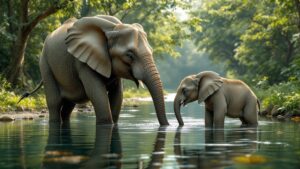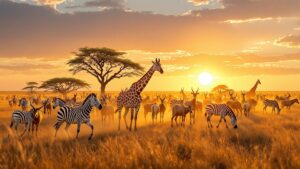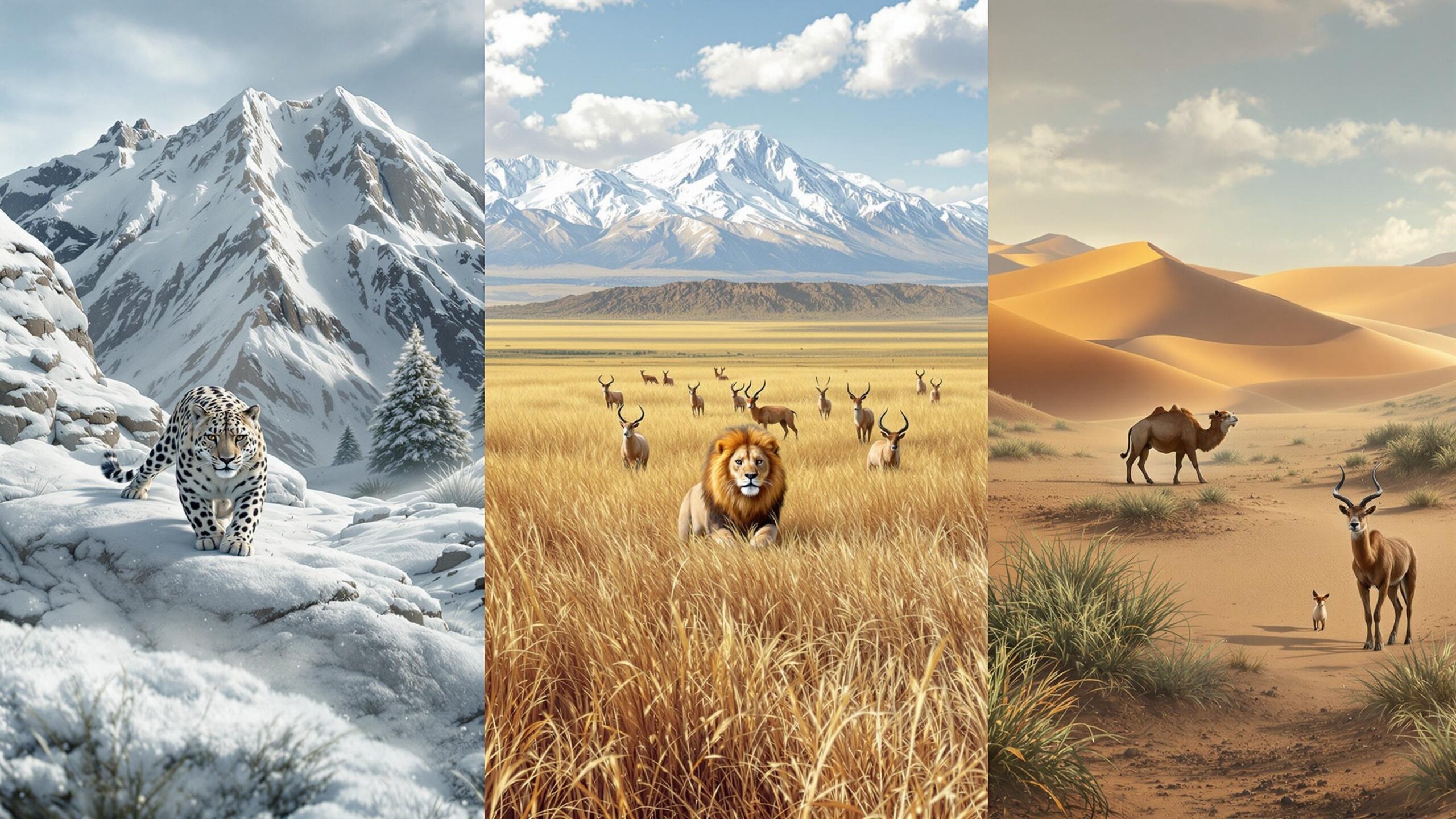Land Mammals: The Dynamic Giants, Sprinters, Foragers, and Architects of Earth’s Wild Landscapes
From the dense canopy of tropical rainforests to the sun-scorched deserts and the icy tundras of the far north, land mammals rule the terrain with stunning diversity and adaptation. They are nature’s travelers, architects, hunters, and caretakers of ecosystems—some lumbering and majestic, others small, swift, and stealthy. Land mammals have walked the Earth for tens of millions of years, evolving into one of the most varied groups in the animal kingdom. Whether galloping across the African plains or burrowing beneath the soil, they are essential players in the grand ecological symphony of life on land.
This page introduces the sprawling universe of land mammals, a group that includes powerful predators, massive herbivores, clever omnivores, and astonishing specialists. It also serves as a gateway to their sub-categories: hoofed mammals, carnivores, primates, marsupials, and land-dwelling insectivores. Together, they form a vivid tapestry of terrestrial life—each species playing a unique role in shaping the world we live in.

Bears
Bears: Nature’s Mighty Mammals of Strength, Strategy, and Survival There’s something deeply captivating about bears. With their sheer physical presence, raw power, and surprisingly gentle family bonds, they inspire both awe and reverence. From the icy Arctic to the misty forests of the Himalayas, these solitary giants roam some of the wildest landscapes on Earth. Bears are not just the lumbering brutes of legend—they are complex, intelligent mammals with an

Big Cats
Big Cats: The Silent Rulers, Stealthy Stalkers, and Supreme Predators of the Wild There is a certain mystique that surrounds the big cats. Their lithe, muscular bodies, piercing eyes, and silent, calculated movements command both fear and admiration. Whether stalking the savannahs, prowling through rainforests, or blending into snowy landscapes, big cats are the apex predators of the mammal world—each species a master of its domain. These elite carnivores have

Domesticated Mammals
Domesticated Mammals: Humanity’s Animal Companions Through Time From cozy homes to sprawling farms and ancient temples to bustling cities, domesticated mammals have journeyed with humans across continents and centuries. They have plowed our fields, carried our burdens, guarded our homes, warmed our hearts, and even shared our beds. Today, domesticated mammals are integral to modern civilization, representing a unique bond between species forged by mutual benefit, adaptation, and trust. But

Elephants
Giants of the Earth: The Spellbinding World of Elephants Imagine stepping quietly into the golden haze of an African savanna at sunrise. A deep rumble vibrates the earth, and through the swirling dust, a herd of elephants emerges—trunks swinging, ears fanned wide, ancient eyes glimmering with intelligence and memory. There is no other animal that commands awe quite like the elephant. With their immense size, intricate social lives, and vital

Hoofed Mammals
Hoofed Mammals: The Earthbound Giants and Fleet-Footed Nomads Across the world’s grasslands, forests, mountains, and deserts, a powerful and diverse group of mammals roams, grazes, gallops, and occasionally leaps with spectacular force. These are the hoofed mammals—creatures that range from the towering giraffes of the African savannah to the elusive mountain goats of alpine cliffs. Known to scientists as ungulates, hoofed mammals make up one of the most ecologically influential

Marsupials
Marsupials: Nature’s Pouch-Bearing Marvels of the Southern Hemisphere When most people hear the word “marsupial,” the image that jumps to mind is the iconic kangaroo bounding across the Australian outback. But this fascinating group of mammals is far more diverse and widespread than many realize. Marsupials represent one of the most extraordinary branches on the mammalian tree, known for their unique method of reproduction and for nurturing their young in

Primates
Primates: The Diverse, Intelligent, and Inquisitive Architects of the Animal Kingdom In the treetops of the Amazon, a howler monkey’s call echoes through the dense canopy. In the forests of Africa, a troop of chimpanzees uses sticks as tools to fish for termites. High in the mountains of Japan, snow monkeys soak in steaming hot springs to stay warm during icy winters. Across continents and climates, primates—one of the most

Small Mammals
Small Mammals: The Quiet Architects of Nature’s Balance In the rustling underbrush of a grassy meadow, a mouse darts beneath a leaf. In the twilight shadows of a forest, a bat takes flight. And in a suburban backyard, a squirrel balances along a fence, bushy tail flicking as it searches for food. Small mammals are everywhere—beneath our feet, above our heads, and often just out of sight. Though their size

Wild Canids
Wild Canids: Masters of Adaptation in the Animal Kingdom There’s a primal thrill in watching a pack of wolves sprint across a snowy expanse, or seeing a jackal slink silently through tall savanna grass, or hearing the eerie whoop of an African wild dog echo across the plains. These are moments that stir something ancient in us—a deep-rooted connection to the wild. Wild dogs and their canine relatives, members of
The Evolutionary March Across Earth’s Terrains
Land mammals trace their lineage back to small, nocturnal creatures that lived during the age of dinosaurs. When the dinosaurs vanished, mammals rose to prominence, rapidly diversifying into the land-dwelling forms we recognize today. Their success is largely due to a few key features: warm-blooded metabolisms, complex brains, highly developed senses, and the ability to care for their young through live birth and nursing.
Over time, land mammals adapted to nearly every ecosystem. In open grasslands, herds of herbivores evolved to graze and migrate over vast distances, while predators became swifter and more cunning. In forests, mammals became expert climbers or burrowers, navigating dense foliage or underground networks. In arid deserts and alpine highlands, they developed specialized traits to endure extreme conditions. What unites all land mammals is their reliance on land-based locomotion and air-breathing lungs, distinguishing them from their aquatic and aerial cousins.
The Great Herbivores: Grazers and Browsers of the Wild
Some of the most iconic land mammals are herbivores—plant eaters that roam the Earth in search of grasses, leaves, bark, fruits, and roots. These include elephants, giraffes, bison, antelope, zebras, and rhinoceroses. Each has evolved distinct body shapes and behaviors to survive in their habitats.
Take the elephant, for instance. Not only is it the largest land mammal, but it also has remarkable intelligence, memory, and emotional complexity. Elephants use their trunks for communication, feeding, and even comforting others. Their presence shapes entire ecosystems, from knocking down trees to create open grasslands to digging for water during droughts, which other animals then use.
Giraffes, with their towering necks and uniquely patterned coats, have adapted to feeding on the leaves of acacia trees high above the ground. Bison and zebras, on the other hand, are built for the plains, moving in vast herds that fertilize the land and control vegetation growth.
These massive herbivores also play a key role in predator-prey dynamics, soil health, seed dispersal, and fire ecology. Despite their bulk, many are surprisingly agile, capable of quick bursts of speed or defensive maneuvers when threatened.
The Fearsome Carnivores: Apex Predators and Stealthy Hunters
Land mammals also include some of nature’s most awe-inspiring carnivores. These meat-eating animals range from solitary stalkers like tigers and cougars to social pack hunters like wolves and African wild dogs. Carnivores have evolved sharp teeth and claws, keen senses of sight and smell, and remarkable agility and endurance.
The lion, known as the “king of the jungle,” commands attention with its powerful build and iconic mane. Living in prides, lions use teamwork to bring down prey and protect their territory. In contrast, the solitary snow leopard blends into its mountainous habitat, relying on camouflage and stealth to ambush prey from above.
Carnivorous mammals are crucial for regulating prey populations and maintaining ecological balance. They often target the sick and weak, helping to ensure the overall health of herds. They also create food opportunities for scavengers, from vultures to hyenas.
Not all carnivores are giants. Small predators like the red fox, badger, and weasel have their own niches. Many are opportunistic feeders, preying on rodents, birds, and insects, often using clever tactics and complex communication.
The Clever and Curious Primates
Primates are among the most intelligent and social of all land mammals. This group includes monkeys, apes, lemurs, and of course, humans. Characterized by large brains, forward-facing eyes, dexterous hands, and a wide range of social behaviors, primates have occupied roles ranging from forest dwellers to urban inhabitants.
Gorillas, the largest of the great apes, live in family groups and display gentle, nurturing behavior. Chimpanzees are tool users and problem-solvers, capable of learning and passing down knowledge through generations. Lemurs, found only in Madagascar, have adapted to a variety of forest environments with behaviors as diverse as their appearances.
Humans, as land mammals, represent an unparalleled leap in the evolution of cognition, creativity, and environmental manipulation. With language, culture, and technology, humans have reshaped the natural world on a global scale.
Primates remind us of the deep evolutionary connections we share with the rest of the animal kingdom. Studying their behavior, emotions, and social systems offers insight into our own roots and the importance of protecting biodiversity.
The Marvelous Marsupials of the Southern Hemisphere
Marsupials are a unique group of land mammals known for carrying and nursing their young in pouches. While they are found mainly in Australia and the Americas, they are a major evolutionary branch with incredible variety.
Kangaroos, wallabies, wombats, koalas, and opossums are all marsupials. Kangaroos are perhaps the most iconic, known for their powerful hind legs and upright hopping motion. Koalas, meanwhile, are tree-dwelling herbivores with a specialized diet of eucalyptus leaves.
Marsupials evolved independently from placental mammals and have adapted to niches that include everything from burrowing to climbing and gliding. The Tasmanian devil, for example, is a scavenger with a powerful bite and vocal range used in social interactions and confrontations.
Despite their regional limitation, marsupials exhibit the same kinds of behaviors and strategies seen in other land mammals. They are resilient survivors, shaped by isolation and selective pressures, and provide a fascinating alternative view of mammalian development.
Insectivores and Small Ground Mammals: Nature’s Underground Network
Not all land mammals are large or social. Some of the most essential species operate behind the scenes—literally—underground. Insectivorous mammals such as moles, shrews, and hedgehogs are small, often hidden creatures that consume insects and other invertebrates. They play a vital role in controlling pest populations and aerating the soil.
Moles are excellent diggers, with shovel-like forelimbs and highly developed sensory systems adapted to darkness. Shrews, among the smallest land mammals, have incredibly fast metabolisms and must eat constantly to survive. Hedgehogs curl into spiny balls when threatened and consume insects, slugs, and even small reptiles.
These mammals are often overlooked but serve as keystone species in their environments. Their digging behavior promotes healthy soil, and their voracious appetites keep insect populations in check. They are also a major food source for larger predators, including owls, foxes, and snakes.
Adaptations for Life on Land
Land mammals have developed an incredible array of adaptations that allow them to navigate the diverse environments of Earth’s surface. Fur or hair helps regulate body temperature in cold and hot climates alike. Strong skeletal systems provide support for running, jumping, climbing, or digging. Sharp teeth and complex digestive systems suit their diets, whether herbivorous, carnivorous, or omnivorous.
Some species, like camels, can survive for days without water thanks to efficient fat storage and heat regulation. Arctic animals, like caribou and polar bears, have dense fur and thick layers of fat for insulation. Desert species, such as the fennec fox, use large ears to dissipate heat and stay cool.
Behavioral adaptations are equally important. Many mammals form social groups for protection, hunting, or raising young. Others are solitary, relying on stealth and territory. Communication through sound, scent, touch, and body language allows mammals to coordinate, warn of danger, or attract mates.
Land Mammals and Human Connection
Land mammals have long been a part of human history, mythology, and culture. We’ve hunted them for food, domesticated them for labor, worshiped them as symbols, and studied them for science. They feature prominently in literature, art, folklore, and spiritual traditions across the world.
Yet, this connection is also a source of conflict. Habitat destruction, climate change, poaching, and pollution threaten countless land mammal species. Iconic animals such as rhinos, orangutans, and snow leopards are endangered, and many more face shrinking ranges and fragmentation.
Conservation efforts are underway across the globe. Protected areas, wildlife corridors, anti-poaching laws, and breeding programs are helping to preserve these creatures for future generations. But success often depends on local communities, global awareness, and a renewed appreciation for the vital role land mammals play in the health of the planet.
Gateway to the Sub-Categories of Land Mammals
To fully appreciate the depth and diversity of land mammals, it’s helpful to explore them by sub-category. Each represents a different evolutionary strategy and ecological role, offering a more detailed look at the incredible ways mammals have adapted to terrestrial life.
Hoofed Mammals (Ungulates): This group includes deer, antelope, horses, and pigs. They are typically herbivores with specialized hooves for walking and running across diverse terrains.
Carnivorous Land Mammals: Including big cats, bears, hyenas, and more, this group is defined by its role in predation and scavenging.
Primates: From lemurs and monkeys to apes and humans, primates offer insight into social evolution, intelligence, and adaptability.
Marsupials: These pouch-bearing mammals are most diverse in Australia and offer an alternative view of mammalian evolution.
Insectivorous and Small Mammals: Often hidden but highly impactful, these species shape ecosystems in subtle but profound ways.
Each category deserves individual exploration and appreciation. Together, they form a living encyclopedia of survival, ingenuity, and ecological interdependence.
The Story of Life Told in Footsteps and Fur
Land mammals embody the story of life on solid ground. Through countless adaptations and evolutionary experiments, they have come to fill nearly every niche available on Earth’s terrestrial surface. They gallop across plains, climb towering trees, hide in burrows, and roam dense forests with purpose and grace.
They are not just animals; they are environmental engineers, cultural symbols, and fellow travelers through time. By understanding and protecting land mammals, we preserve not only their future but our own. Their stories are written into the soil, the trees, and the wind—each one a reminder that life on land is as dynamic and breathtaking as the creatures that call it home.

